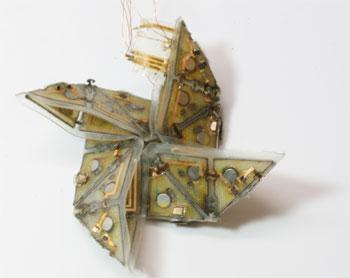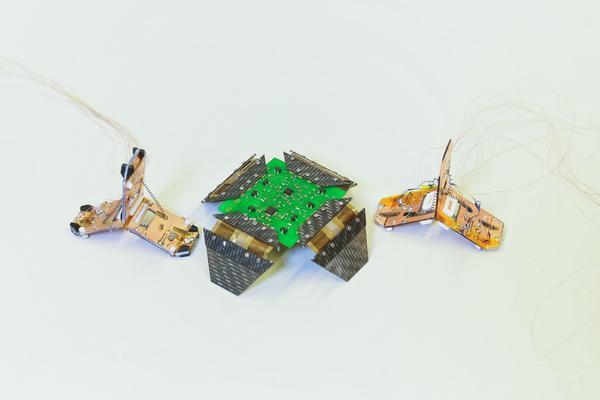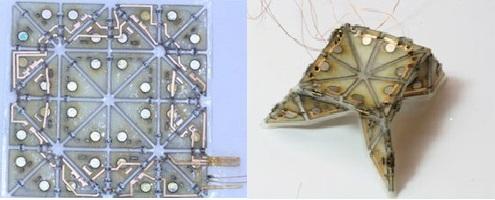 Robots and origami. Those are two things I never would have put together, but mechanical engineering professor Jamie Paik and her team at the Reconfigurable Robotics Lab, part of Switzerland’s Ecole Polytechnique Fédérale de Lausanne, have done exactly that. Introducing Robogami, which is exactly what it sounds like – robots modeled on origami. Light, paper-thin and foldable, robogamis are designed as a series of connected flat sheets with embedded actuators that enable them to move, crawl, jump and fold themselves into a compact, origami-like shape.
Robots and origami. Those are two things I never would have put together, but mechanical engineering professor Jamie Paik and her team at the Reconfigurable Robotics Lab, part of Switzerland’s Ecole Polytechnique Fédérale de Lausanne, have done exactly that. Introducing Robogami, which is exactly what it sounds like – robots modeled on origami. Light, paper-thin and foldable, robogamis are designed as a series of connected flat sheets with embedded actuators that enable them to move, crawl, jump and fold themselves into a compact, origami-like shape.
Paik, the daughter of a scientist and an artist, drew on her own artistic sensibilities and love of origami forms to create the concept of robogami.
“Unlike other robots, which need to have a fixed tasks and form at the time of design and fabrication, I want my robots to be like origami, which is very versatile with its form,” she said. “And for robots, it will be versatile with its actions, which means its tasks.”
 The team’s most recent robogami model, dubbed “Tribot,” was unveiled recently at the 2015 International Conference on Intelligent Robots and Systems in Hamburg, Germany. The conference is currently running until October 2nd. Tribot, unlike its predecessors, can simultaneously switch between jumping and crawling, meaning it can jump over obstacles and continue moving forward without stopping. The team was inspired by nature when creating the robot’s locomotion: Tribot’s crawling mode was based on the movement of the inchworm, while its jumping motion was based on fleas.
The team’s most recent robogami model, dubbed “Tribot,” was unveiled recently at the 2015 International Conference on Intelligent Robots and Systems in Hamburg, Germany. The conference is currently running until October 2nd. Tribot, unlike its predecessors, can simultaneously switch between jumping and crawling, meaning it can jump over obstacles and continue moving forward without stopping. The team was inspired by nature when creating the robot’s locomotion: Tribot’s crawling mode was based on the movement of the inchworm, while its jumping motion was based on fleas.
“This unusual robot can jump up to seven times its height, and it does not need to be reset between jumps,” said Paik.
Tribot is 2 centimeters tall and weighs a mere 4 grams. Its predecessor, a four-legged crawling robot, is scarcely larger. Because of their small size, conventional motors were too heavy and bulky to use for locomotion purposes. Therefore, the robogamis’ movement actuators are made from shape memory alloy, a material that is capable of remembering its initial shape after being deformed. The researchers built the actuators from nickel and titanium shape memory alloys that, when heated with electric currents or wireless micro-heaters, generate movement in different directions.
“We gave the robot numerous actuators, each of which is insulated from the others,” said Zhenishbek Zhakypov, a doctoral student who works as an assistant in the lab. “By activating the actuators successively, the robot begins to crawl. The jumping mode depends on springs that are also made out of SMA.”
Where does 3D printing come in? When discussing how the robots could be manufactured on a mass scale, the team suggested 3D printing as an easy and quick way to manufacture the multiple layers needed to construct the robot. The layers needed to assemble a crawling robot consist of curvature sensors, SMA actuators, control circuit, and heaters for activating the SMA actuators. The layers could be easily shipped and assembled in a process that Paik compares to the assembly of Ikea furniture.
What does robogami mean for the future? A lot, potentially. Its changeable modes of locomotion and ability to react spontaneously to its environment hold potential for numerous applications: for example, it could be used to independently navigate across rough terrain, making it an invaluable resource in search and rescue missions.
“Once it has been carefully programmed, the origami sheet can self-morph into a small table, or a little house, or even an airplane…the possibilities are infinite,” said Paik.
Currently the team is working on adding additional sensors such as accelorometers and micro cameras, as well as having the robots interact with each other. You can read in more detail about robogami in a journal article co-authored by Paik and doctoral assistant Amir Firouzeh.
What are your thoughts on this robot? Discuss in the 3D Printed Origami Robot forum thread on 3DPB.com.
See robogami in action here:
Subscribe to Our Email Newsletter
Stay up-to-date on all the latest news from the 3D printing industry and receive information and offers from third party vendors.
Print Services
Upload your 3D Models and get them printed quickly and efficiently.
You May Also Like
Josh Makeshift and the New Gold Standard 3D Printing Content Creation
In the beginning, 2007 or so, 3D printing videos were almost wholly absent from the web. Then, here and there, makers started to upload pictures of their rickety RepRaps and...
Making Space: Stratasys Global Director of Aerospace & Defense Conrad Smith Discusses the Space Supply Chain Council
Of all the many verticals that have been significant additive manufacturing (AM) adopters, few have been more deeply influenced by the incorporation of AM into their workflows than the space...
EOS in India: AM’s Rising Star
EOS is doubling down on India. With a growing base of aerospace startups, new government policies, and a massive engineering workforce, India is quickly becoming one of the most important...
A 3D Printed Lab Tool for Space Biology Survives Spaceflight
When it comes to space missions, even the smallest tools have to be light, tough, and reliable, and one small device is proving just how powerful that combination can be....

































